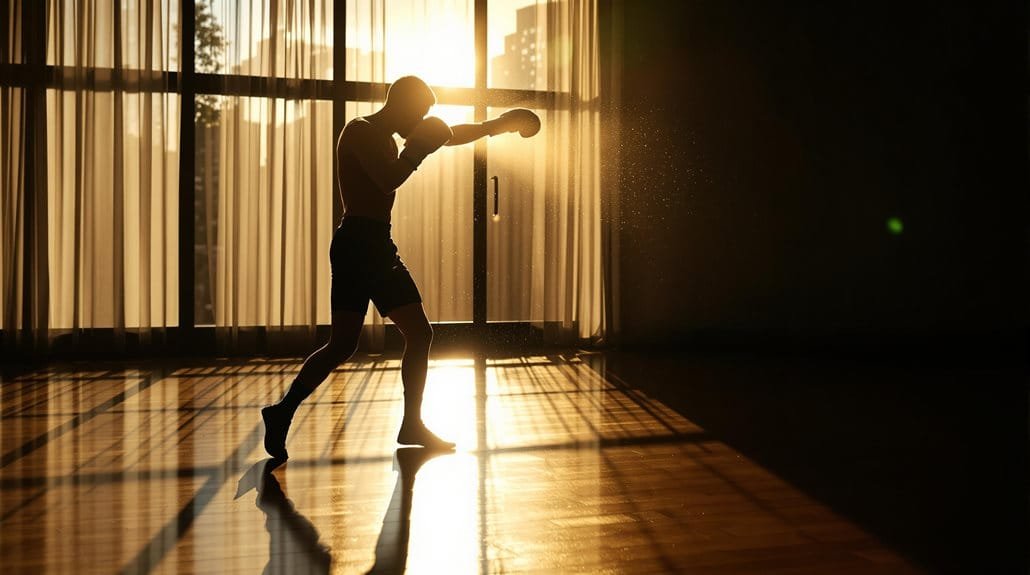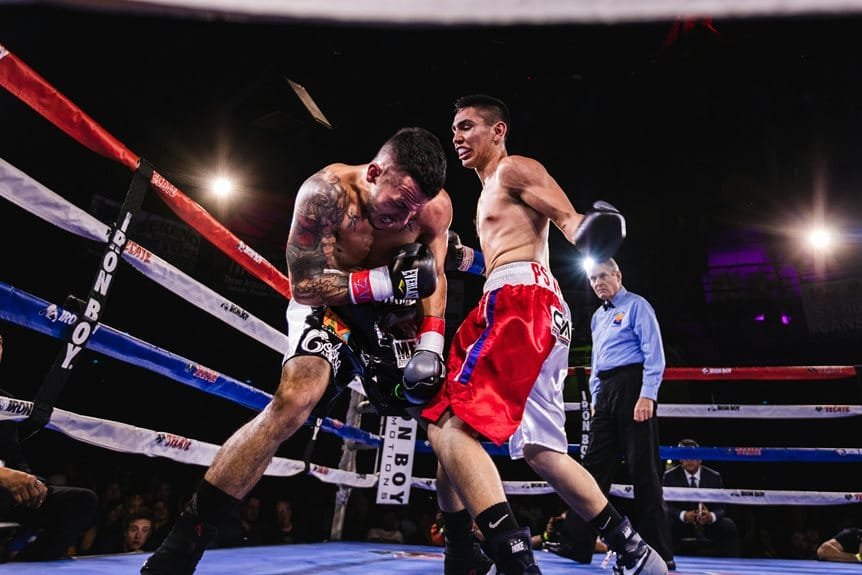Want to get better at boxing without spending lots of money? Try shadowboxing – it's like having a gym wherever you go! You can do it at home, in a hotel room, or pretty much anywhere with enough space to move around.
When you shadowbox, you're practicing punches and movements without hitting anything. This helps you get better at your timing and makes your boxing moves feel more natural. It's also great for learning how to move your feet the right way.
Even though shadowboxing might look easy when you watch someone do it, there's actually a lot going on. Good shadowboxing takes real skill and practice. The best boxers pay close attention to every punch and step they take.
Think of shadowboxing as your personal boxing teacher that's always ready to help you train. The more you do it, the better you'll get at the basics of boxing – and you don't need any special equipment to get started.
Table of Contents
Essential Shadowboxing Equipment
Want to get started with shadowboxing? You don't need any equipment, but these three items can really help your training.
Light 2-pound dumbbells are great for building arm strength and making your punches faster. Your arms will get tired at first, but they'll get stronger over time.
Hand wraps are important if you're serious about training. For best protection, you'll want to use 180-inch traditional wraps. They keep your wrists straight and protected while you punch, which helps prevent injuries.
A mirror might be the most useful tool of all. It lets you watch yourself move and fix any mistakes in your form. Think of it as your personal coach that shows you exactly what you're doing right or wrong.
You can add other equipment too, like jump ropes and resistance bands.
It's also good to switch between using boxing gloves and bare hands. Gloves help build strength, while practicing without them helps you work on speed and proper form.
Basic Stance and Movement
Let's start with how to stand and move the right way. Put your front foot at an angle, kind of like pointing to 2 o'clock on a clock. Keep more of your weight on your back foot, and bend your knees a little bit to help you stay balanced and move quickly.
Your feet are super important in boxing – they're like your foundation. When you want to move forward or backward, start with your front foot and let your back foot follow. Keep your feet about shoulder-width apart as you move around.
As you move around, shift your weight smoothly from one foot to the other. Always keep one foot following the other so you stay balanced. Your front foot should stay near the middle while your back foot stays firm on the ground.
Mastering the Jab

The jab is the most basic punch in boxing, but getting it right takes practice and attention to detail. When throwing a jab, you need to fully extend your arm while shifting your weight from your back leg to your front leg. Don't forget to pivot your back foot to keep your balance. The most effective jab comes from pushing off the back foot.
It's helpful to practice your jabs in front of a mirror so you can watch your form. When you're practicing jabs, make sure your feet move together with your punches. Watch out for common mistakes – don't give away your punch before throwing it, and remember to pivot properly.
Keep your punching hand in a fist but your guard hand open to save energy. As you move around, bob and weave while keeping your body centered.
Try to imagine real boxing situations while you practice. Focus on hitting the same spot consistently and mix your jab with other punches. This will help you use your jab better in actual boxing.
Head Movement Drills
Let's talk about moving your head to avoid getting hit in boxing. After you get good at throwing jabs, you need to learn how to move your head out of the way of punches. This helps you stay safe and find chances to hit back.
Moving your head isn't just about dodging – it helps you set up your own punches too. You'll want to practice moving your head to the left and right, using your hips and legs to stay strong and balanced. The Peekaboo side step technique allows you to transfer weight effectively while throwing punches.
Here are some simple drills to help you get better:
- Hang a rope at shoulder height and practice ducking under it while stepping forward and back.
- Stand in front of a mirror and watch yourself move, pretending to dodge punches coming at you.
- When you shadowbox, mix up your footwork with head movement – duck under pretend hooks and move at different angles.
Just remember to keep those hands up when you duck under punches.
And always use your legs and hips to stay balanced and strong. The more you practice, the more natural these movements will feel.
Advanced Footwork Combinations

To become really good at boxing, you need to learn how to move your feet while throwing punches. Think of it like dancing – you want your feet and hands working together smoothly.
When you're practicing by yourself (that's called shadowboxing), work on moving your feet in smart ways. Turn your body to find better angles, step back when you need to dodge, and move around like you're facing a real opponent.
Picture someone trying to hit you, and move your feet to stay safe while throwing your punches. Just remember to keep good form – don't get sloppy with your movements.
Building Speed and Endurance
Want to get better at shadowboxing? You need to work on two things – being quick and having enough energy to keep going.
Let's start with speed. Try working in short bursts – punch fast for 10 seconds, then slow down a bit to catch your breath. Focus on throwing quick punches and combinations, but always make sure you're doing them the right way. During intense bursts, maintain active foot movement to maximize your performance.
For building up your energy, you'll want to keep moving for longer periods. Try boxing for three minutes at a time, then rest for one minute, just like in a real boxing match.
Here are some good ways to practice:
- Go all-out for 20 seconds, rest for 10 seconds, and do this six times.
- Shadowbox for 30 minutes every day to help your heart get stronger.
- Act out fight scenes to get used to how a real match feels.
The key is to keep practicing regularly. Start slow and make it harder as you get better. If you work on both speed and staying power, you'll become a much better shadowboxer.
Integration With Heavy Bag Training

Let's talk about mixing your shadowboxing with heavy bag training. Once you've gotten faster and can box longer without getting tired, hitting the heavy bag will make you even better at boxing.
Start simple – try some basic punch combinations on the bag to get your timing right. Switch back and forth between hitting the bag and shadowboxing. You'll feel how hitting the bag makes your punches stronger, and this carries over when you go back to shadowboxing.
Try moving around the bag like it's a real opponent. This helps you practice stepping and moving from different angles.
The more you practice both ways of training together, the better you'll get at throwing smooth combinations while keeping good form and staying at the right distance.
Frequently Asked Questions
How Long Should a Beginner Shadowbox per Session to Avoid Fatigue?
When you're new to shadowboxing, start with short 10-minute workouts. Break these up into 3-minute rounds of punching and moving, with 1-minute breaks in between. This way, you won't get too tired or lose your form.
Think of it like learning to run – you start with short distances before trying a marathon. The same idea works here. Your body needs time to get used to all the new movements.
Can Shadowboxing Help Improve Reaction Time in Other Sports?
Shadowboxing can definitely help make you quicker in other sports. When you practice throwing punches and moving around without a real opponent, your brain and body learn to react faster.
Think of it like a fun workout that trains your muscles and mind at the same time. You're constantly moving, dodging, and making quick decisions – all skills that come in handy whether you're playing basketball, soccer, or tennis.
The best part is that these quick movements become natural over time. Your body gets better at responding quickly, and this improved reaction time carries over into whatever sport you play.
Should You Shadowbox With Weights or Resistance Bands?
When it comes to shadowboxing, leave the weights and resistance bands aside. They can mess up the way you naturally move and make you slower.
Instead, focus on getting your form and technique just right. This way, you'll get all the good stuff that shadowboxing has to offer, like better speed, coordination, and muscle memory.
Think about it like this: you want your punches to be quick and sharp in a real fight, so practice them the same way when you shadowbox. Keep it light and natural – that's the best way to train.
Is It Better to Shadowbox in Front of a Mirror?
Shadowboxing in front of a mirror can really help you fix your form and see what you're doing right or wrong. It's like having a coach watching your every move.
But don't just stick to mirror practice. You need to mix it up by doing regular shadowboxing too. This way, you'll feel more sure of yourself when you're not looking at your reflection.
The best plan is to do both – some days with the mirror, some days without. This helps you become a more well-rounded fighter who can perform well in any situation.
How Often Should You Switch Between Orthodox and Southpaw Stances?
Start out spending most of your time (about 80%) in your stronger stance – the one that feels most natural. Only use your other stance about 20% of the time at first.
As you get more comfortable switching between stances, you can start spending a bit more time in your weaker stance. Eventually, aim to use your stronger stance about 70% of the time and your weaker stance 30% of the time.
This gradual approach helps you learn how to use both stances effectively while still relying mainly on your stronger position.
Conclusion
Now you have everything you need to get better at shadowboxing. You can practice anywhere – in your living room, at the gym, or even outside.
Just remember to do the moves the right way and pay attention to how you move your feet. Try different punch combinations to keep things fresh. Stay bouncy and light when you move around.
Start slow, then work up to faster, harder moves as you get better. The more you practice these moves, the better you'll get at boxing. Plus, you'll get in great shape too!




